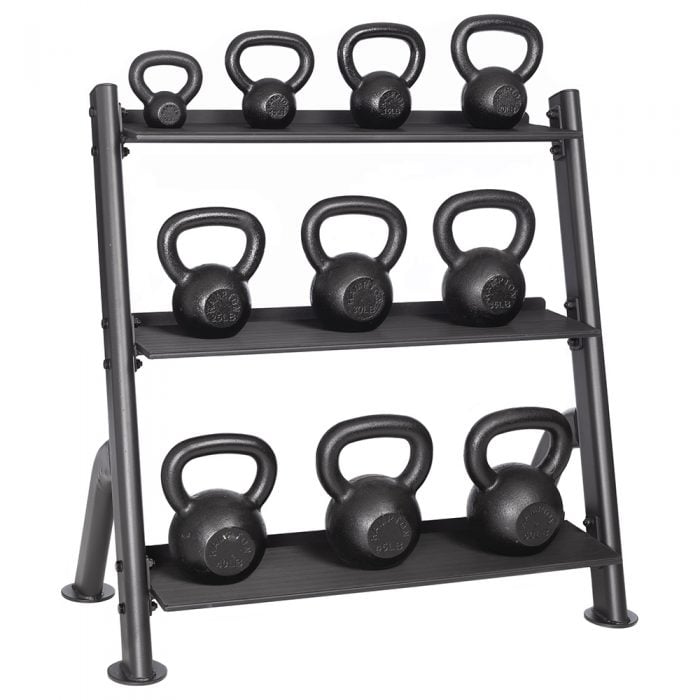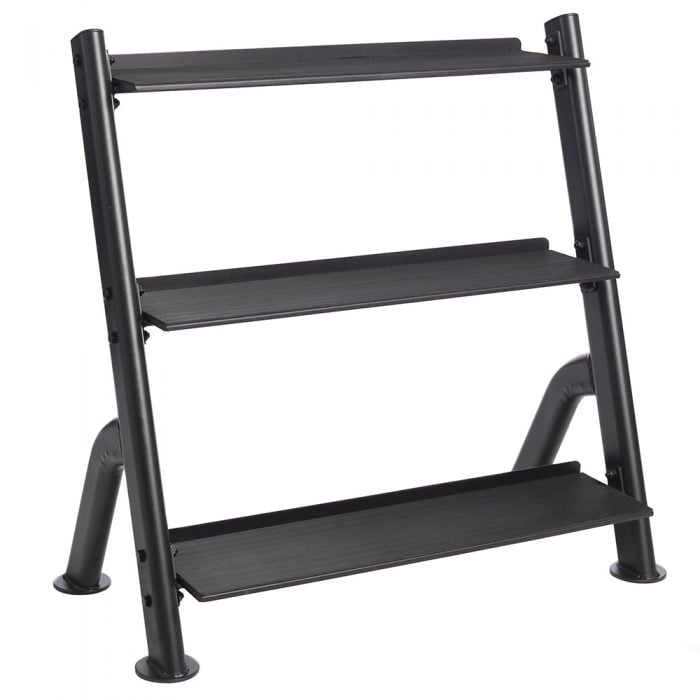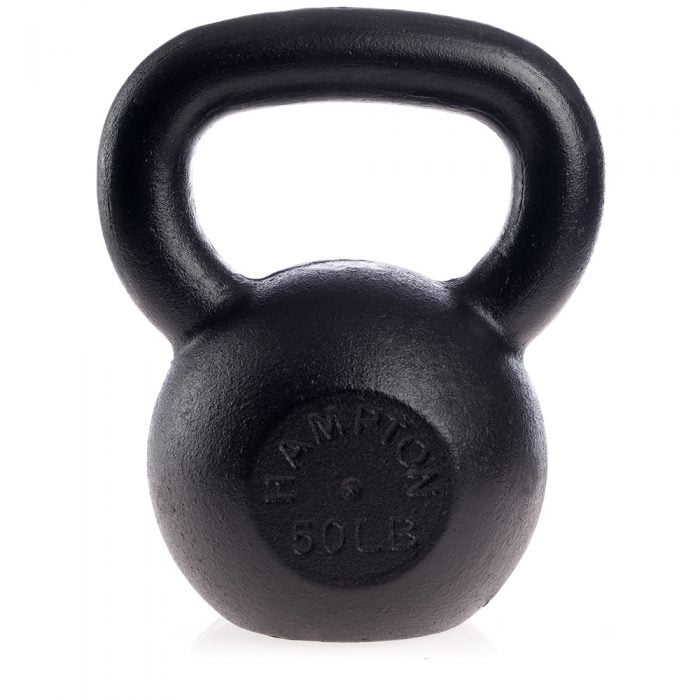Key Takeaways:
- Kettlebell workouts target multiple muscle groups, making them the ideal exercise to help you build strong legs.
- Staples like swings, squats, and lunges are effective building blocks for the ideal leg workout.
- Kettlebell quality is important, so ensure that you have a good set that will help you make the most of each exercise.
Introduction to Kettlebell Training for Leg Development
Embarking on a journey to build strong legs can be both exhilarating and demanding, yet incorporating kettlebell leg exercises into your routine could radically transform your approach to leg strength. Kettlebell exercises offer dynamism and versatility that traditional leg exercises sometimes lack, engaging your muscles holistically and promoting functional fitness. Whether you’re a seasoned athlete or a fitness enthusiast, a kettlebell workout is an exceptional technique to enhance power and stability in your lower body.
Starting with kettlebell swings, which target the hamstrings and glutes, you’ll ignite a fire in the powerhouse of your leg muscles. Next, the kettlebell squat is a foundational move that builds thigh and hip strength and engages your core and lower back, creating an incredibly efficient full-body effect. Stepping up the intensity, lunges with a kettlebell pass-through challenge your balance and coordination, further amplifying leg strength. Finally, the single-leg deadlift using a kettlebell will test your unilateral stability and promote muscular harmony across your legs. Each kettlebell leg exercise is a stepping stone to develop muscle mass and enhance agility and endurance. As you blend these kettlebell exercises into a cohesive kettlebell workout, you’ll discover the beauty of kettlebell training for its ability to offer swift yet significant outcomes.
Below, we’ll break down each major kettlebell exercise, how to perform it, and what it does to your body. However, before you begin your leg regimen, you need to ensure that your kettlebells are up to snuff. These exercises involve some high intensity, and you want equipment that’s high quality and can keep up with all your activities. That’s where Hampton Fitness comes in. Our kettlebell selection offers top-notch tools that will withstand your toughest training. We’ll bring the equipment; you bring the dedication and jump into the exercises below!
Foundational Leg Muscles Targeted by Kettlebell Exercises
When it comes to building strong legs, a kettlebell leg workout is a powerful tool that targets key muscular groups essential for lower body strength and mobility. Each kettlebell exercise is meticulously designed to engage the foundational leg muscles, ensuring efficient and effective workouts. The primary focus is the quadriceps, hamstrings, and calves, with movements like kettlebell squats, lunges, and deadlifts providing a well-rounded leg workout. Moreover, the dynamic nature of kettlebell leg workouts promotes functional strength that applies to everyday activities.
One of the significant advantages of using kettlebells for your legs is their ability to combine strength training with cardiovascular benefits. Exercises such as kettlebell swings work the posterior chain and elevate your heart rate, providing a dual benefit. Another compelling aspect of kettlebell leg workouts is the variety they bring to your training regimen, keeping the workouts both challenging and engaging. With kettlebells, you can easily incorporate unilateral moves, like single-leg deadlifts, to address imbalances and build unilateral strength, making every leg workout with kettlebells a comprehensive approach to fitness.
Whether you’re a beginner or a seasoned athlete, kettlebell exercises can be scaled to match your fitness level, making kettlebell leg workouts suitable for all. As you progress, increasing the weight or complexity of the kettlebell movements can continuously challenge your legs, ensuring consistent growth and improvement. Your journey towards enhanced leg strength and definition can substantially benefit from the strategic inclusion of kettlebell exercises. With dedication and the right workouts, you’ll see remarkable gains in the power and resilience of your lower body, making kettlebell leg workouts a staple for anyone serious about leg development.
Recommended products
-
Traditional “Old School” Kettlebell Packs
$1,147.00 – $2,605.00 -
3-Tier Horizontal Kettlebell Rack
$469.00 -
Hampton Kettlebell – Black Powder Coated
$12.00 – $246.00
Essential Kettlebell Leg Exercises
Embarking on the journey to build strong legs, you’ll find that the versatility of kettlebells offers an unmatched efficient workout. The unique design of kettlebells makes them an ideal tool for various dynamic movements, which can significantly enhance your lower body strength and endurance.
An important fundamental exercise is the kettlebell squat. It targets your quads, hamstrings, and glutes, providing a solid foundation for muscle growth and power. The beauty of kettlebell leg training is that even a single exercise can activate numerous leg muscles simultaneously.
Another core exercise is the kettlebell lunge, which challenges your balance and entire lower body, making it a must-have in any routine aimed at sculpting and strengthening leg muscles.
As you progress, incorporating the kettlebell deadlift will take your leg day to new heights. This hinge movement focuses on the posterior chain, building the lower back, hamstrings, and glutes for comprehensive leg development.
To dial up the intensity, kettlebell swings unleash a full-body exercise that predominantly hammers your legs while engaging your core and shoulders. The seamless motion from a deep squat to a powerful hip thrust exemplifies why kettlebells have become a staple in effective leg workouts. For those ready to elevate their game, snatch and clean exercises with kettlebells can provide explosive power and an astonishing range of motion, ensuring every fiber in the leg muscles is activated and ready to grow.
Remember that proper form trumps everything as you weave these kettlebell leg exercises into your regimen. A kettlebell leg exercise performed incorrectly will not only jeopardize results but may also lead to injury. So, take your time to master the movements, and with these kettlebell workouts, you’ll be on your way to building strong, powerful legs that are equipped for any physical challenge.
Kettlebell Swings
Kettlebell swings are pivotal in kettlebell leg training, offering a dynamic approach to building strong legs. As you power through a swing, the orchestrated thrust comes from the leg muscles, driving the kettlebell upward with explosive energy. This leg workout is not just about the swing but about the harmony of multiple muscles working in concert. Engaging the hamstrings, quadriceps, glutes, and calves, kettlebell swings provide a comprehensive leg exercise that enhances athletic performance and overall leg strength.
The beauty of this particular kettlebell exercise lies in its simplicity and impact. It’s a movement that can be integrated into fitness routines for athletes of all levels and scaled up or down using different kettlebell weights. Moreover, it’s a leg workout that doesn’t just focus on muscle building but also on improving cardiovascular fitness and endurance. The repetition of kettlebell swings can increase your heart rate, making it an excellent exercise for those looking to burn calories and increase stamina.
When it comes to performing kettlebell swings, proper form is paramount. Maintaining a slight bend in the knees and hinges at the hips is essential, as well as keeping the back flat as the kettlebell is swung between the legs. The force should come from the hips as they extend, with the arms guiding the weight rather than lifting it. Consistent practice of this leg workout will sculpt your lower body and build a foundation of functional strength that will benefit daily activities and athletic pursuits. So, if you want to enhance your leg workout routine, consider incorporating kettlebell swings as a staple exercise for transformative results.
Goblet Squats
When it comes to kettlebell leg exercises, the goblet squat stands out as a premier movement for building strong legs. This versatile kettlebell workout targets the quadriceps, hamstrings, and glutes, effectively working the major muscles of the thighs. It’s an exercise that strengthens these fundamental muscle groups and enhances stability and balance throughout the lower body. To perform a goblet squat, you’ll hold a kettlebell close to your chest with both hands as if cradling a goblet. Ensuring your feet are shoulder-width apart, you’ll descend into a squat, driving your hips back and down while keeping your chest upright—a crucial aspect of maintaining proper form.
As you lower your body, focus on the tension through your thighs, feeling the exercise’s impact on those essential muscles. The upward phase of the goblet squat is equally important; push through your heels, utilizing the power of your legs to return to the starting position. This kettlebell leg exercise isn’t just about building muscle; it’s also about cultivating muscle endurance and coordination, making it an invaluable component of a comprehensive kettlebell workout. Including exercises like kettlebell swings in your routine are important, but goblet squats add a unique dimension to your leg training, targeting the thighs with a precision that complements the dynamic movements of swings.Incorporate goblet squats into your kettlebell workout to ensure a well-rounded approach to your leg exercises. Whether you’re new to working with kettlebells or you’re looking to intensify your routine, goblet squats can be adjusted in weight to suit any fitness level. Remember, consistency is key in any exercise regimen, and integrating kettlebells into your routine can lead to remarkable leg strength and power. Be patient with your progress, and watch as kettlebell leg exercises transform your lower body’s capabilities.
Lunges and Variations
When it comes to kettlebell leg training, lunges are a versatile staple that can dramatically enhance strength and definition in your legs. A leg workout featuring kettlebell lunges targets the full spectrum of leg muscles with a special emphasis on the thighs. Utilizing a kettlebell not only adds weight to traditional lunges but also introduces an element of balance and core engagement that is unique to kettlebell exercises. Variations of lunges, such as walking lunges, reverse lunges, and side lunges, keep the routine fresh and allow for comprehensive leg development, hitting different angles and challenging your muscles in new ways.
Incorporating lunges into your leg workout routine will ensure you’re building strength and power and improving coordination and stability. This is crucial as strong legs are the foundation of almost every movement in your daily life. Whether you’re stepping up into a stride or maneuvering through dynamic sports, the performance of your legs is enhanced by the variety and adaptability of lunges. The thighs will become more resilient, the calves stronger, and your overall leg definition more pronounced. Thanks to the varied applications of kettlebell lunges, you’ll see progress in muscle endurance and explosive strength.
To diversify the leg workout further, the kettlebell can be held differently with each lunge variation. For instance, pass a single kettlebell hand-to-hand at the bottom of each lunge for a more challenging variation, or press the kettlebell overhead to bring even more muscle groups into play. Whatever variation you choose, lunges will be an invaluable part of your ultimate kettlebell leg regimen. You’ll steadily forge strong legs by weaving these into your routine, supporting your fitness ambitions and everyday activities.
Deadlift Variations
For those looking to enhance their leg workout with kettlebell exercises, venturing into deadlift variations can be a game-changer. The deadlift is a pivotal lifting exercise that has stood the test of time due to its effectiveness in building raw strength and muscular endurance, particularly in the legs. When performed with a kettlebell, this movement not only engages the essential muscles of the lower body but also offers convenience and versatility that other lifting equipment can’t match.
Starting with the kettlebell deadlift, this foundational move activates your glutes, hamstrings, quads, and calves, offering a full-scale assault on the leg muscles. However, the variations of the kettlebell deadlift unlock the potential for an unbeatable kettlebell leg workout.
One such variation is the single-leg kettlebell deadlift, which incorporates balance and core stability and is a phenomenal exercise for those looking to strengthen their legs and boost their overall athletic performance. Another variation, the sumo kettlebell deadlift, requires a wider stance and targets the inner thighs and glutes.
Each kettlebell exercise in these deadlift variations is more than just a leg workout; it’s an opportunity to develop unparalleled functional strength. They foster an environment where the muscles work through compound movements that carry over into real-world activities and sports.
Integrating these kettlebell exercises into your routine ensures that you’re not only lifting weights but also investing in strength that translates outside the gym. Deadlift variations are vital for those who value a holistic and robust approach to kettlebell leg training.
Step-Ups and Box Jumps
Continuing our ultimate kettlebell leg workout, let’s focus on dynamic moves that blend power with stability—step-ups and box jumps. These exercises are fabulous for those looking to spice up their leg workout regimen with some athleticism. Step-ups, performed by stepping onto a raised platform with a kettlebell in hand, target the quads, hamstrings, and glutes. They’re a functional exercise that simulates real-world activities, like climbing stairs, but also serves as a way to build leg strength and endurance. Incorporating a kettlebell into this move elevates the intensity, turning a simple movement into a comprehensive kettlebell leg exercise.
On the other hand, box jumps are a plyometric powerhouse, ideal for developing explosive leg power and enhancing overall athletic performance. While they don’t directly involve kettlebells, box jumps complement kettlebell leg workouts by promoting quick, powerful movements that engage the foundational leg muscles in a different, yet incredibly effective, manner. Perform these by leaping onto a sturdy platform and then stepping down to repeat. It’s essential to land softly with knees slightly bent to absorb the impact. And don’t forget to monitor your form throughout to prevent injury.
Incorporating step-ups and box jumps into your workouts adds a high-intensity interval flavor, making your kettlebell leg training routine about building strong legs and improving coordination and cardiovascular fitness. With kettlebells in hand, you can transform basic step-ups into an invigorating leg challenge. Don’t avoid alternating your leg workout with these exercises to keep your muscles guessing and your motivation high. So, grab your kettlebells, and let’s leap into action; your path to strong legs is just a jump away!
Turkish Get-Ups
Widely considered a full-body exercise, the Turkish get-up is nonetheless a superb component of any kettlebell leg training program due to its multi-joint movements, which heavily involve the legs for stabilization and movement. Turkish get-ups enhance leg strength, flexibility, and endurance when integrated into a kettlebell workout.
This exercise demands skill and focus, as each step involves a sequence of movements that must be performed precisely. Beginning flat on the ground, you must strategically move to a seated position and then to a standing position, all while holding the kettlebell skyward, putting considerable work into the legs.
During this exercise, the legs are in constant use, functioning to stabilize your body and support the weight of the kettlebell. This continuous tension builds muscle endurance and strength in the lower body. For those seeking to develop powerful legs, Turkish get-ups must be included in their kettlebell workout routines. The exercise leverages the legs and engages the core, making it a holistic approach to leg development and functional strength.
Incorporating Turkish get-ups into your exercise regimen provides a dynamic challenge that transcends traditional leg programs. Unlike isolated movements, this exercise requires a blend of mobility, balance, and raw strength, guaranteeing that your legs are being trained comprehensively. Whether you’re performing a kettlebell workout at home or in the gym, Turkish get-ups are versatile and require minimal space, making them an essential part of your workout toolkit. Ultimately, Turkish get-ups epitomize the philosophy of kettlebell exercises – functional, efficient, and challenging – ensuring that your journey to stronger legs is both robust and rewarding.
Structuring a Kettlebell Leg Workout
When you want to build powerful, sculpted legs, kettlebell leg workouts provide an incredible opportunity to challenge and strengthen your lower body. Structuring a kettlebell leg workout demands strategy and understanding of the foundational leg muscles targeted by kettlebell exercises.
Craft your routine to include the essential kettlebell leg exercises mentioned earlier, such as kettlebell swings, which ignite the posterior chain, and goblet squats that relentlessly work the quads and glutes. Integrate lunges and their variations for added agility and balance, and don’t skip deadlift variations – these are pivotal for overall leg and lower back strength.
Step-ups and box jumps will inject power and explosiveness into your kettlebell leg workout, while Turkish get-ups provide a full-body challenge that demands coordination and core stability.
Attention to the frequency and intensity of the sessions is crucial to ensuring the effectiveness of your kettlebell leg workouts. Beginners should start slow, possibly with lighter weights, to master form before progressing.
As for the veterans in kettlebell training, pushing the boundaries with increased weight or more complex movements is essential for continual leg development. Incorporating variety in your kettlebell leg workout can help avoid plateaus and ensure balanced muscle growth. This might involve alternating between high-rep, lower-weight workouts and sessions with fewer reps but higher kettlebell weights.
Remember, consistency is key to seeing substantial results. Aiming to perform kettlebell leg workouts at least twice a week allows adequate recovery time between sessions while still keeping the muscles engaged and progressing.
Recommendations for warm-up and cool-down routines
Embarking on a kettlebell leg training program demands a thoughtful approach to preparing and protecting your muscles post-exercise. A dynamic warm-up should precede any kettlebell leg exercises to enhance flexibility, rev the heart rate, and lubricate the joints.
Start with five minutes of light cardio – such as jogging or jumping jacks – to get the blood flowing to your legs. Progress to dynamic stretches like leg swings and walking lunges, focusing on the lower body to prepare your legs for the upcoming workout.
Post-warm-up, integrate specific exercises that mimic the movements of your upcoming routine. Bodyweight squats and light kettlebell swings can bridge your body from a general warm-up to the specific demands of the workout ahead. This primes your muscles, including those foundational leg muscles crucial to kettlebell training, for peak performance and injury prevention during the more intense exercise phases.
After you’ve completed the sessions of goblet squats, lunges with variations, deadlift variations, and robust Turkish get-ups, it’s paramount to decrease your heart rate gradually with a proper cool-down. This can involve a blend of static stretches that target the muscles you’ve engaged—hamstrings, quads, calves, and glutes. Holding each stretch for approximately 20-30 seconds can help muscle recovery and flexibility.
Additionally, using a foam roller to perform myofascial release on your legs can help alleviate soreness caused by the workout. In your kettlebell leg exercise program, never underestimate the power of an effective warm-up and cool-down routine – they’re the supporting pillars for any workout to build strong legs. These routines are fundamental in keeping your leg muscles healthy, functional, and ready for your next kettlebell challenge.
Tips for Maximizing Your Kettlebell Leg Workouts
Focus on form and function to effectively harness the power of kettlebell leg workouts. The unique nature of kettlebell exercises allows for a dynamic blend of strength, agility, and endurance, directly translating to better leg strength and overall performance. Begin each leg workout with a proper warm-up to prepare your muscles and joints for the demands of kettlebell training. Incorporating movements that mimic your workout exercises, such as light goblet squats, can activate the foundational leg muscles you’ll be targeting.
Progression is key in building leg workout routines; therefore, as you grow more comfortable with basic moves like kettlebell swings and lunges, challenge yourself by increasing weight or adding variations to keep your workouts stimulating. Maintaining a balanced approach is crucial, ensuring you’re not overloading your muscles and risking injury. Remember that your body needs adequate recovery after rigorous kettlebell exercises, so intersperse heavy workout days with lighter ones or focus on different muscle groups.
Proper breathing can’t be overstated during kettlebell workouts. It helps power through those last demanding reps and maintains a strong core throughout each motion. The notion of ‘ mindful movement ‘ is vital to refining your workouts. Pay attention to the muscles you’re engaging during goblet squats or deadlift variations; this focus can significantly increase the effectiveness of your leg workout. To close your kettlebell leg session, don’t skip the cool-down.
This phase helps in reducing muscle soreness and aids in recovery. Finally, to build strong legs with your kettlebell routine, stay consistent. Leg strength won’t develop overnight, but regular, strategic workouts will substantially progress your kettlebell leg training journey.
Finally, don’t forget the importance of good kettlebells. Grab your Hampton set, and you’ll be ready to confidently tackle leg day!





